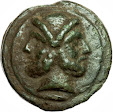L.SAVF
Lucius Saufeius, 152 BC
I
fell in love with this coin when I saw it several weeks ago. I was not looking
to upgrade a coin I bought in 2011. I had to wait extra time while the MOU
between the US and Italy went into effect, but eventually received the coin. In 2011, I did not have a coin dated around 150 BC, so this one was a nice addition to my
collection. The new one looks almost perfect from the dealer’s photos. I assume
it will that good when it arrives.
I noted recently that I am buying more cast bronze and less silver coins. This one not a change in direction as much as really liking the coin.
My "new" coin.
My "old" coin.
Roman
Republican Silver Denarius, 152 BC, Rome
L.SAVF
– Lucius Saufeius
Obverse
– Head of Roma R wearing a winged helmet decorated with a gryphon’s head;
wearing ear rings with 3 drops, middle one is long and others are pellets;
wearing necklace; hair in 3 locks; X behind head
Reverse
– Victory, naked to hips, driving biga, horses galloping (or prancing), whip in
R hand and reins in L hand, L.SAVF below (archaic style L), (VF in monogram),
ROMA in partial linear frame at bottom of coin.
The border for ROMA has been
described several ways:
·
On
tablet (although I do not think this coin series has a tablet like the early coins)
·
In
exergue
·
In
linear frame
·
In
linear frame in exergue
·
On
raised tablet, in exergue
I think there
are two main styles here. Most coins have a partial linear frame (a box with two
or three sides). I have seen none with a 4th side or a line below
ROMA. Small flans or off center strikes cut off some or all of the two side
lines. A few coins have just a long exergue line.
The
Saufeia gens appears to be from Praeneste and is not mentioned before 100 BC.
This moneyer issued silver (denarius) and bronze coins (As, Semis, Triens,
Quadrans & Sextans).
Cr
– 204/1, Crawford estimates 117 obverse and 146 reverse dies => a common RR denarius.
BMCRR
– 835 Gruber notes the two examples in his book have different ear rings: #835
(and mine) has ear rings with a longer center droplet, #834 has similar sized
droplets.
Sear
– 83
RSC/Bab
– Saufeia 1
Syd
– 384
RBW
– 874
Albert
– 874
NMW
– 235 – 237
NMCr
– 44 – 45
I compared the size and weight of other coins in my books on the internet. The results:
Weight = 3.7 grams, my coin #1
Weight = 3.8 grams, my coin #2
Weight - max 4.32
Weight - min 3.15
Weight - avg 3.83
Weight - st dev 0.22
Number 108 Note - found 106 in books and two sites & stopped looking
Diameter - 18.27 mm, my coin #1
Diameter - 17.1 mm, my coin #2
Diameter - max 20.0
Diameter - min 16.0
Diameter - avg 17.6
Diameter - st dev 0.75
Grade, vendor - SPL+
Grade, mine - EF, plus comments below
Centering - Well centered on flan that is only slightly larger than the die.
Strike - well struck from new dies
Flan flaws - none
Style - good style, plenty of fine details
Patination - light toning
Damage - none













